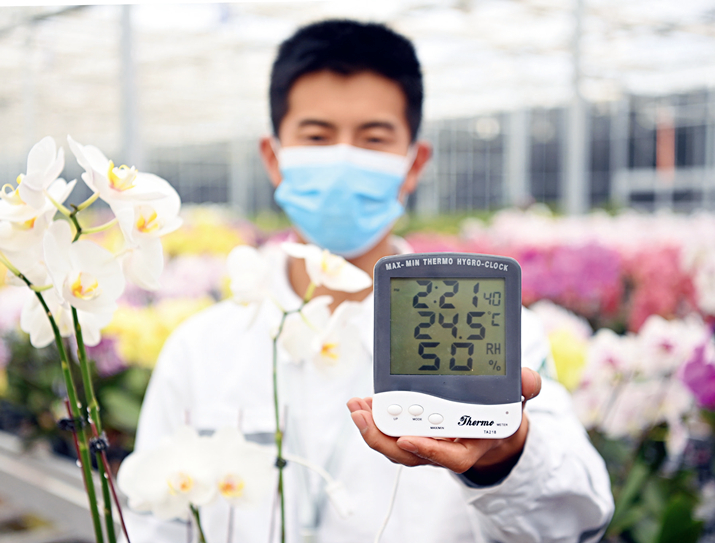Adding smart wings to agriculture
 0 Comment(s)
0 Comment(s) Print
Print E-mail ChinAfrica, April 2, 2022
E-mail ChinAfrica, April 2, 2022

As an old Chinese saying goes, "Food is the paramount necessity of the people." China is a large agricultural country, and for this reason, it is vital to ensure a healthy development of agriculture.
To that end, China will vigorously promote the construction of digital villages, development of smart agriculture, and integration of information technology into agricultural machinery and agronomy applications, according to the Opinions of the Central Committee of the Communist Party of China and the State Council on the Key Tasks to Comprehensively Push Forward Rural Revitalization in 2022, released in February. It is China's 19th No.1 Central Document to guide the work of the "agriculture, rural areas and farmers" since the year 2000.
With the continuous development of science and technology, its integration into the field of traditional agriculture has become an inevitable trend in agricultural modernization, leading to the emergence of what is known as smart agriculture.
"Smart agriculture is a new agricultural production method which involves information gathering, quantitation-based decision-making, intelligent control, precise input and tailored service by deeply integrating modern information technology such as Internet of Things (IoT), big data and artificial intelligence into agriculture. It's of historic significance to agricultural development," Zhao Chunjiang, Academic Dean of the College of Information Engineering of Northwest A&F University, said.
In simple terms, it refers to the use of modern science and technology to achieve unmanned, automatic and intelligent management of the agricultural production process. It can boost efficiency and reduce carbon footprint, while creating opportunities for rural revitalization.
Favorable policies
On March 9, China's Ministry of Agriculture and Rural Affairs issued the National Plan for Agricultural and Rural Informatization During the 14th Five-Year Plan period (2021-26), making systematic arrangements for the high-quality development of agricultural and rural informatization.
The plan proposed that smart agriculture is the main direction of agricultural and rural informatization development, mainly focusing on seven aspects including seed industry, soil management, planting, animal husbandry, fisheries, farm machinery and land reclamation.
The plan pointed out that by 2025, smart agriculture will reach a new level, the informatization rate of agricultural production will reach 27 percent, and the annual online retail sales of agricultural products will exceed 800 billion yuan ($125.8 billion). It proposes the establishment of 100 national digital agricultural innovation bases, and 200 agricultural and rural informatization demonstration bases.
The development of smart agriculture is not only an important policy made at the national level, but also a realistic need to transform the development mode of agriculture.
According to Wang Maohua, Academician of the Chinese Academy of Engineering, the digital economy is accelerating its integration with the real economy, becoming an important way to deepen the structural reform on the supply side and promote innovation-driven development.
Wang believes that the popularization and application of the new generation technology will enhance agricultural quality and efficiency, green development, cost saving and rural incomes.
Any technology that can effectively improve the resource utilization rate of soil, water, fertilizer, light and heat, and protect environment will become a new hot spot for research in the development of smart agriculture, noted Wang.
According to the Ministry of Agriculture and Rural Affairs, China has identified nine provinces to conduct agricultural IoT demonstration projects, set up 100 digital agricultural pilot projects and 210 national agricultural and rural informatization demonstration bases, and supported informatization innovation of nearly 120,000 sets of agricultural machinery.
In addition, the country is also formulating policies to support smart agriculture, covering subsidies for agricultural machinery, development of agricultural and rural informatization standards, training of digital agricultural professionals, and raising the awareness of rural officials and administrative personnel on informatization.
Role of enterprises
Although China's smart agriculture development has unprecedented opportunities, it also faces a series of challenges.
"Take China's agricultural IoT as an example. It is in its infancy and faces a series of development bottlenecks in terms of technology and application," said Li Daoliang, Professor at China Agricultural University.
One of his suggestions is to encourage social forces to focus more on smart agriculture. "It's necessary to vigorously support leading enterprises to strengthen their innovation and operation capabilities, and encourage the development of technologies and equipment for smart agriculture such as drones," said Li.
China's IT giant Lenovo Group, for examples, has created a complete set of intelligent agricultural solutions including IoT, big data, and comprehensive service and unified monitoring platform tailored for Shaanxi Four Apples Industry Co. Ltd., which effectively integrates data on production, management, sales channels and order matching for apple growing. It realizes unified supervision of the local apple industry, and the traceability of each apple can be realized through a QR code. In the future, this system will also enable intelligent management of agricultural visualization, and remote diagnosis, remote control, and disaster warning.
Shaanxi Four Apples worked with only 28 fruit farmers in 2016, managing an apple planting area of 20 hectares. After using Lenovo's system, the company is now able to contract more than 1,700 fruit farmers, achieving an output value of more than 170 million yuan ($26.7 million). Not only has it solved the marketing problem by growing high-quality apples, but also created hundreds of agricultural jobs for the local area.






Go to Forum >>0 Comment(s)